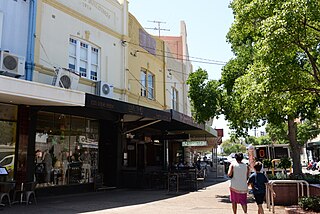
Randwick is a suburb in the Eastern Suburbs of Sydney, in the state of New South Wales, Australia. Randwick is located 6 kilometres south-east of the Sydney central business district and is the administrative centre for the local government area of the City of Randwick. The postcode is 2031.
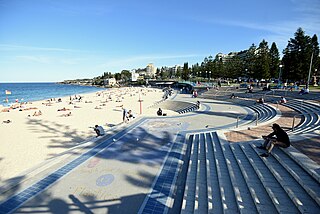
Coogee is a beachside suburb in the Eastern Suburbs of Sydney, in the City of Randwick. Coogee is located 8 kilometres south-east of the Sydney central business district, in the state of New South Wales, Australia.

The Long Bay Correctional Complex, commonly called Long Bay, is a correctional facility comprising a heritage-listed maximum and minimum security prison for males and females and a hospital to treat prisoners, psychiatric cases and remandees, located in Malabar, Sydney, New South Wales, Australia. The complex is located approximately 14 kilometres (8.7 mi) south of the Sydney CBD and is contained within a 32-hectare (79-acre) site. The facility is operated by Corrective Services New South Wales, a department administered by the Government of New South Wales.
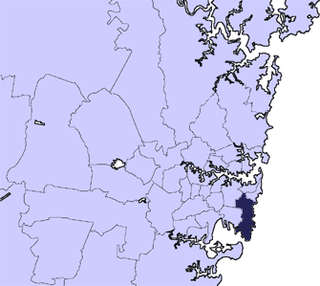
The City of Randwick is a local government area in the Eastern Suburbs of Sydney, New South Wales, Australia located south-east of the CBD. Established in 1859, Randwick is the second-oldest local government area in New South Wales, after the City of Sydney. It comprises an area of 36 square kilometres (14 sq mi) and as at the 2016 census had a population of 140,660.

South Coogee is a coastal suburb in the Eastern Suburbs of Sydney, in the state of New South Wales, Australia. South Coogee is located 9 kilometres south-east of the Sydney central business district, in the local government area of the City of Randwick.

The Malabar Headland is a heritage-listed former public recreation area and military installation site and now nature conservation and public recreation headland area located at Franklin Street, Malabar in the City of Randwick local government area of New South Wales, Australia. It is also known as Long Bay Rifle Range, Anzac Rifle Range and Boora Point. The property is owned by the New South Wales Government. It was added to the New South Wales State Heritage Register on 22 July 2005.

Emanuel School is an independent Jewish co-educational early learning, primary and secondary day school, located on a heritage-listed campus in the Sydney eastern suburb of Randwick, in New South Wales, Australia. The school was founded in 1983 in Woollahra. The current Randwick site was purchased in 1984 and was opened in 1985. In 1986, Prime Minister Bob Hawke officially opened the school. Emanuel School currently caters for approximately 800 students from Kindergarten to Year 12. The Principal has been Mr. Andrew Watt since 2018. The school is affiliated with the Jewish Communal Appeal, the Junior School Heads Association of Australia (JSHAA), and the Association of Heads of Independent Schools of Australia (AHISA).

The Prince Henry Hospital site, formerly known as the Prince Henry Hospital, Sydney, is a heritage-listed former teaching hospital and infectious diseases hospital and now UNSW teaching hospital and spinal rehabilitation unit located at 1430 Anzac Parade, Little Bay, City of Randwick, New South Wales, Australia. It was designed by NSW NSW Colonial Architect and NSW Government Architect and built from 1881 by NSW Public Works Department. It is also known as Prince Henry Hospital and The Coast Hospital. The property is owned by Landcom, an agency of the Government of New South Wales. It was added to the New South Wales State Heritage Register on 2 May 2003.

Wylie's Baths is a heritage-listed tidal swimming pool located near Coogee Beach, in the Eastern Suburbs of Sydney, New South Wales, Australia. The baths are noted for holding the first Australian Swimming Championships and for being one of the first swimming baths for mixed gender swimming in Australia. The Baths were added to the New South Wales State Heritage Register on 14 November 2003 and are also classified by the National Trust of Australia.

The St Jude's Church is an active Anglican church in Randwick, a suburb of Sydney, New South Wales, Australia. It is part of a significant heritage group that includes the church, cemetery, rectory and original Randwick Borough Chambers, later converted to church use. The group is located on Avoca Street, Randwick, and has a federal heritage listing. It was added to the New South Wales State Heritage Register on 2 April 1999.

The Ritz Cinema, also known as the Ritz Theatre, is a heritage-listed cinema located at 43 St Pauls Street, in the Sydney suburb of Randwick in the City of Randwick local government area of New South Wales, Australia. It was designed by Aaron Bolot and built in 1937 by C. & B. J. Williams. It was added to the New South Wales State Heritage Register on 2 April 1999. The architect, Aaron Bolot, is known for his classic art deco buildings throughout Sydney, such as his commissions for grand apartment buildings in Potts Point.
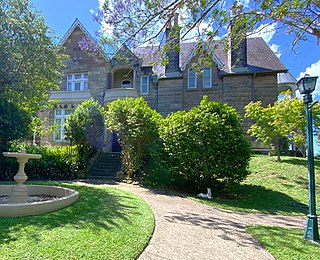
Nugal Hall is a heritage-listed Gothic Revival style former private residence, ambassador's residence, boutique lodge, embassy and now private residence located at 16-18 Milford Street, in the Sydney suburb of Randwick on the boundary with the suburb of Coogee. Nugal Hall sits in the City of Randwick local government area as part of the Eastern Suburbs of Sydney in New South Wales, Australia.

Cliffbrook is a heritage-listed former residence, school and government building and now university research, administration building and university press located at 45-51 Beach Street, Coogee in the City of Randwick local government area of New South Wales, Australia. Built in 1921, its design is attributed to John Kirkpatrick. The building is owned by the University of New South Wales. The property was added to the New South Wales State Heritage Register on 2 April 1999.

Sandgate is a heritage-listed former residence, repatriation hospital and heritage centre at 128 Belmore Road, Randwick, City of Randwick, New South Wales, Australia. It was built during 1879 by Simeon Pearce. It is also known as Kilkerran and Felton. The property is owned by Randwick City Council. It was added to the New South Wales State Heritage Register on 2 April 1999.

Venice is a heritage-listed apartment building and residence in Randwick, City of Randwick, New South Wales, Australia. It was built from 1884 to 1885 by Stephen Gee. It was added to the New South Wales State Heritage Register on 2 April 1999.

The Randwick Presbyterian Church is a heritage-listed Presbyterian church building located at 162 Alison Road in the Sydney suburb of Randwick in the City of Randwick local government area of New South Wales, Australia. The church was designed by Sir John Sulman and built from 1889 to 1890 by George Gale. The property is owned by the Randwick Presbyterian Church and was added to the New South Wales State Heritage Register on 8 May 2008.

The Randwick Post Office is a heritage-listed former post office located at 124 Alison Road in the Sydney suburb of Randwick in the City of Randwick local government area of New South Wales, Australia. The former post office was designed by Walter Liberty Vernon in his capacity as NSW Government Architect and was built from 1897 to 1898 by W. B. Chessell. It is also known as Randwick Post Office (former) and Jubilee Fountain. The property is owned by Australia Post (Federal Government). It was added to the New South Wales State Heritage Register on 23 June 2000.

Corana and Hygeia are a heritage-listed pair of semi-detached residences at 211-215 Avoca Street in the Sydney suburb of Randwick in the City of Randwick local government area of New South Wales, Australia. They were built from 1893 to 1894. They are also known as Corana & Hygeia Victorian Terraces,Corona, Randwick Lodge and has recently re-branded to The Lurline. The property is privately owned. It was added to the New South Wales State Heritage Register on 2 April 1999.

Hooper Cottage is a heritage-listed residence at 17 Gilderthorpe Avenue in the Sydney suburb of Randwick in the City of Randwick local government area of New South Wales, Australia. It was built from 1847 to 1848. It was added to the New South Wales State Heritage Register on 2 April 1999.
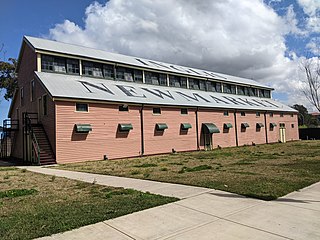
The Big Stable Newmarket is a heritage-listed former Aboriginal land, farm stables, residence, hotel, factory and detention centre and now stables at 29-39 Young Street in the Sydney suburb of Randwick in the City of Randwick local government area of New South Wales, Australia. It is also known as Cranbrook Stables;. It was added to the New South Wales State Heritage Register on 2 April 1999.





















